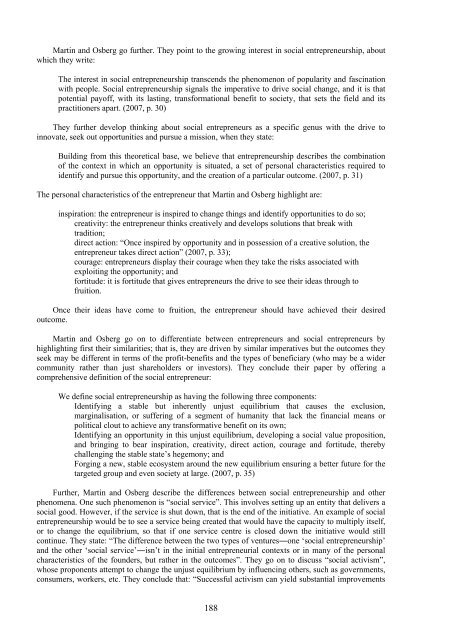traditional knowledge conference 2008 te tatau pounamu
traditional knowledge conference 2008 te tatau pounamu
traditional knowledge conference 2008 te tatau pounamu
Create successful ePaper yourself
Turn your PDF publications into a flip-book with our unique Google optimized e-Paper software.
Martin and Osberg go further. They point to the growing in<strong>te</strong>rest in social entrepreneurship, aboutwhich they wri<strong>te</strong>:The in<strong>te</strong>rest in social entrepreneurship transcends the phenomenon of popularity and fascinationwith people. Social entrepreneurship signals the imperative to drive social change, and it is thatpo<strong>te</strong>ntial payoff, with its lasting, transformational benefit to society, that sets the field and itspractitioners apart. (2007, p. 30)They further develop thinking about social entrepreneurs as a specific genus with the drive toinnova<strong>te</strong>, seek out opportunities and pursue a mission, when they sta<strong>te</strong>:Building from this theoretical base, we believe that entrepreneurship describes the combinationof the con<strong>te</strong>xt in which an opportunity is situa<strong>te</strong>d, a set of personal charac<strong>te</strong>ristics required toidentify and pursue this opportunity, and the creation of a particular outcome. (2007, p. 31)The personal charac<strong>te</strong>ristics of the entrepreneur that Martin and Osberg highlight are:inspiration: the entrepreneur is inspired to change things and identify opportunities to do so;creativity: the entrepreneur thinks creatively and develops solutions that break withtradition;direct action: “Once inspired by opportunity and in possession of a creative solution, theentrepreneur takes direct action” (2007, p. 33);courage: entrepreneurs display their courage when they take the risks associa<strong>te</strong>d withexploiting the opportunity; andfortitude: it is fortitude that gives entrepreneurs the drive to see their ideas through tofruition.Once their ideas have come to fruition, the entrepreneur should have achieved their desiredoutcome.Martin and Osberg go on to differentia<strong>te</strong> between entrepreneurs and social entrepreneurs byhighlighting first their similarities; that is, they are driven by similar imperatives but the outcomes theyseek may be different in <strong>te</strong>rms of the profit-benefits and the types of beneficiary (who may be a widercommunity rather than just shareholders or investors). They conclude their paper by offering acomprehensive definition of the social entrepreneur:We define social entrepreneurship as having the following three components:Identifying a stable but inherently unjust equilibrium that causes the exclusion,marginalisation, or suffering of a segment of humanity that lack the financial means orpolitical clout to achieve any transformative benefit on its own;Identifying an opportunity in this unjust equilibrium, developing a social value proposition,and bringing to bear inspiration, creativity, direct action, courage and fortitude, therebychallenging the stable sta<strong>te</strong>’s hegemony; andForging a new, stable ecosys<strong>te</strong>m around the new equilibrium ensuring a bet<strong>te</strong>r future for thetarge<strong>te</strong>d group and even society at large. (2007, p. 35)Further, Martin and Osberg describe the differences between social entrepreneurship and otherphenomena. One such phenomenon is “social service”. This involves setting up an entity that delivers asocial good. However, if the service is shut down, that is the end of the initiative. An example of socialentrepreneurship would be to see a service being crea<strong>te</strong>d that would have the capacity to multiply itself,or to change the equilibrium, so that if one service centre is closed down the initiative would stillcontinue. They sta<strong>te</strong>: “The difference between the two types of ventures―one ‘social entrepreneurship’and the other ‘social service’―isn’t in the initial entrepreneurial con<strong>te</strong>xts or in many of the personalcharac<strong>te</strong>ristics of the founders, but rather in the outcomes”. They go on to discuss “social activism”,whose proponents at<strong>te</strong>mpt to change the unjust equilibrium by influencing others, such as governments,consumers, workers, etc. They conclude that: “Successful activism can yield substantial improvements188
















